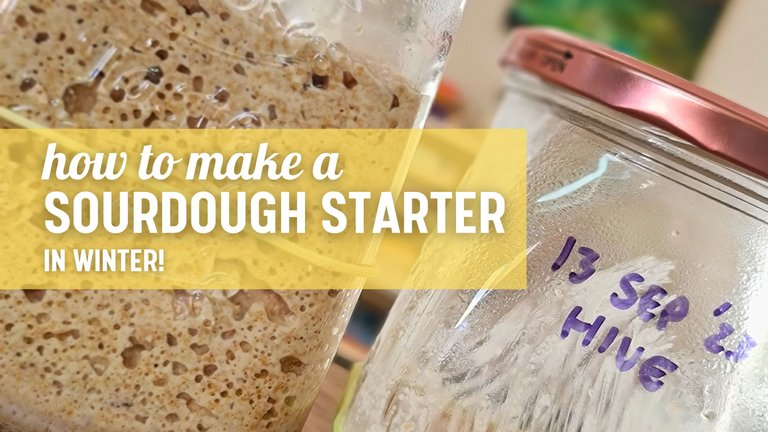
I needed a more interesting life.
I could start by learning something.
I could start with the starter.”
― Robin Sloan
Whilst my sourdough "making and baking" journey is essentially in infancy, my love for this history rich bread, began a few years back when staying at my dad's place, because he bought a fresh loaf weekly from the local health shop, which generally got devoured very quickly, and though I was quite happy to buy and eat it on a regular basis - it was only once we moved into our new place that I began to explore the "how" of it all.
Bread - a staple which I think we all have a pretty consistent "love/hate" relationship with. It is the one thing we all love to eat but live in constant denial of it's many negatives, which are especially prominent for those of us who have long since crossed the 30yrs mark.
My Inspiration for Sourdough
My curiosity for the process of making sourdough was actually inspired by my now halted exploration of all things "almond". At the time we were purchasing almond breads, flours etc. because of its "supposed reputation" as a healthier and lower carb option. I had experimented with making quite a bit with almond flour - but every SINGLE time I did, I could not shake this niggling (and very logical, to me any way) thought about the INSANE volume of almond nuts we must be consuming by eating almond bread, almond flour based pizzas, and eating the nuts themselves.
I mean think about it - one cup of almond flour has close to one hundred almond nuts in it! That on it's own is already a crazy number... and most loaves of almond flour bread require about two cups of almond flour - and that renders a relatively small loaf of bread which would definitely not take you very long to consume.
This got me reading and it did not take very long to find several articles with quite startling facts about the whole "almond, keto craze' - but this is the article which ultimately made up my mind and got me to start looking elsewhere.
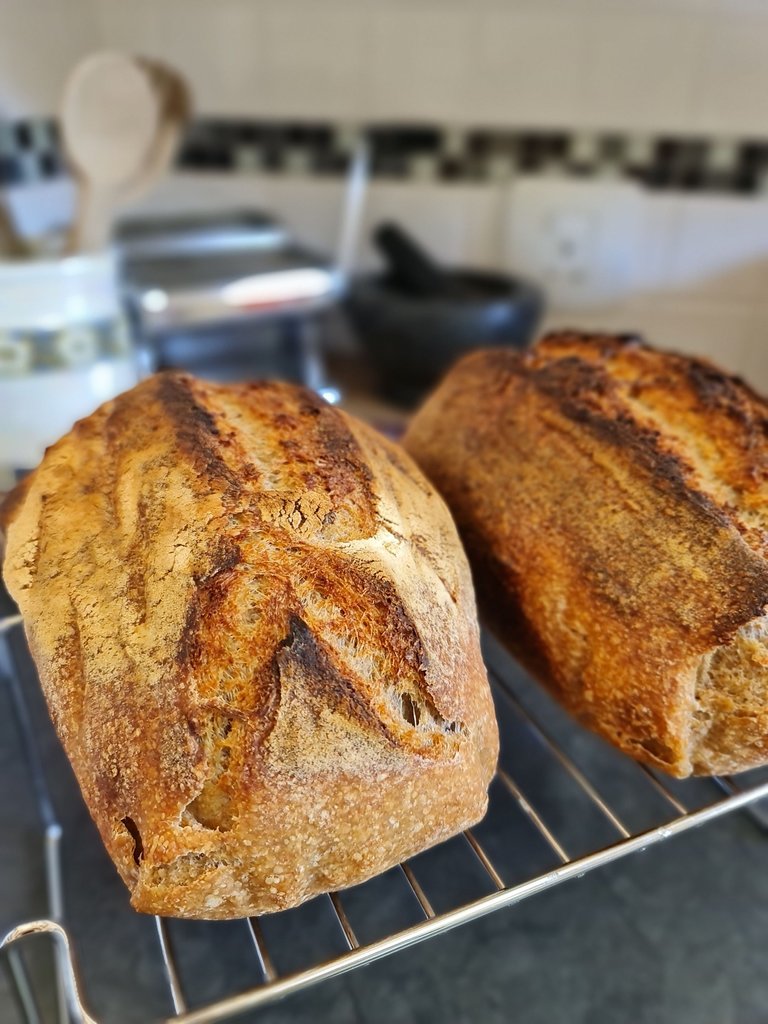
I began searching things like "the healthiest bread on earth", haha! Well, again and again I was met with the same results. Number one on the list is sprouted whole grain bread - which is something I would still like to explore... and number two on the list - yes, you guessed it... sourdough.
I have done some extensive reading on sourdough over the last few months, but I will save the details of that for another time. There really is a lot to learn and also to consider when actively trying to make healthier choices - but for now, I am happy to be heading in at least the right direction. Not to mention that sourdough is not cheap around these parts, with the average loaf selling for between 40 & 50 Zar, which is just more than double the price of traditional breads.
And so the adventure began. I had absolutely no clue what made sourdough unique, nor did I know I would need to cultivate a starter first in order to make the bread. Yes, I do know you can buy the starters, but I wanted to do this from scratch, by myself.
So what is a Sourdough Starter?
In short, sourdough bread is made using natural yeast - and that is precisely what your starter is... a fermented form of dough which is filled with wild yeast and the GOOD bacteria called lactobacilli. This is what sets sourdough aside from more conventional breads which make use of commercial yeast.
Learning the in's and out's of making a starter has been such a fantastic adventure so far - with plenty trial, error and experimentation. Much like with the loaves of bread themselves, each sourdough starter is completely unique and will render different results.
There are literally ENDLESS articles, recipes and videos online with "how to's" and I have tried several of them. One thing I have learnt most so far... is that this is definitely a very personal journey and I think each person should do what works best for them as an individual (much like with everything else in life). I have done a "bit of this" and a "little of that" - tried things, tested others and whilst I continue to learn... I have now found a method and process which works perfectly for me and suits my routine.
One of the things I struggled with most initially was that I decided to start this adventure at the beginning of one of our coldest Winters evaaaar, and much like my fur child - sourdough starters do not like the cold. This led me to explore workarounds which have proven very successful - one of those little secrets lying in one tiny little ingredient... honey!
This little wonder ingredient has proven a superbly successful workaround for creating a starter in the colder months and that is because the enzymes which are within honey not only improve the break down process from starch to sugar, but they also increase the growth rate of microbes which ultimately fast tracks the fermentation process. Adding honey to your starter has a handful of other benefits too, like improved flavour and the addition of antioxidants.
Starting the Starter
As I have gone along, I have also discovered a few other tips which help in the colder weather - such as feeding your starter with MUCH warmer water. I generally boil the kettle, let it stand for about ten minutes and then use that water to feed my starters. However, before we can feed a starter we need to START the starter!
I actually decided to begin a new starter for this post so that I can document the process for all of you and perhaps even dehydrate and post it to those of you interested in reviving a starter from South Africa, hehe! - Although, I would still need to explore the legalities of sending something like that over the seas! So, Let's get to it!!
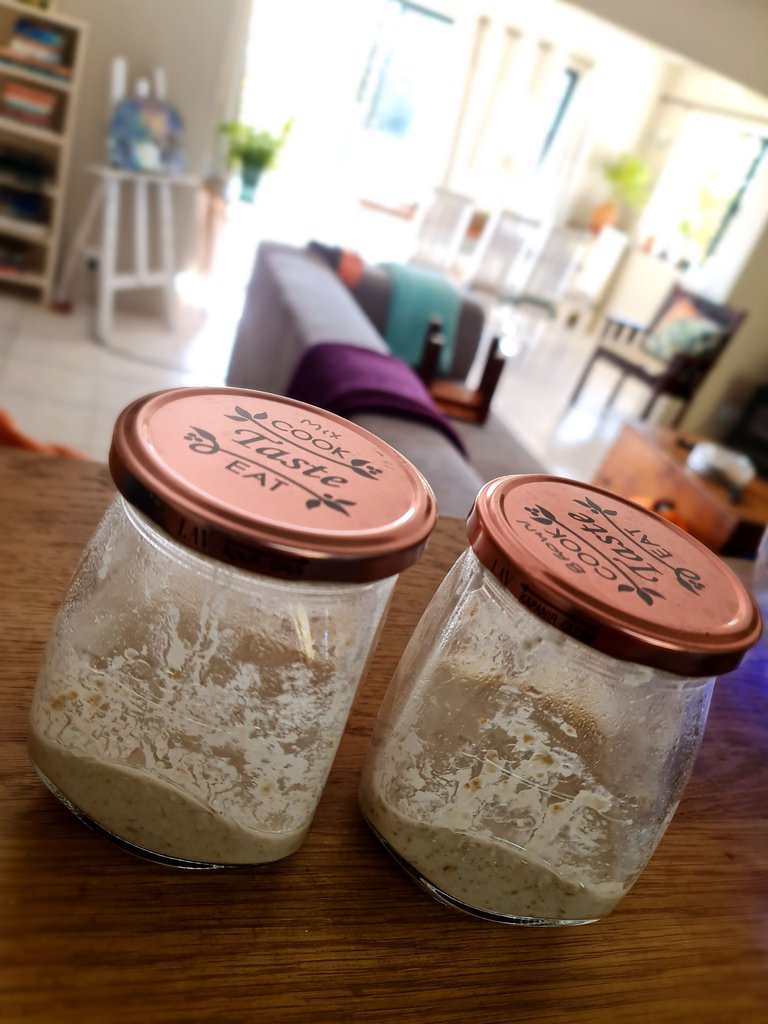
WHAT YOU WILL NEED:
1 x kitchen scale
1 x glass jar & lid
1 x elastic band (I use thin hairbands)
1 x knife, spoon or even fork for mixing.
50 grams of unbleached wholewheat flour
50 grams of VERY WARM (but not boiling) water
1/2 a tsp of honey
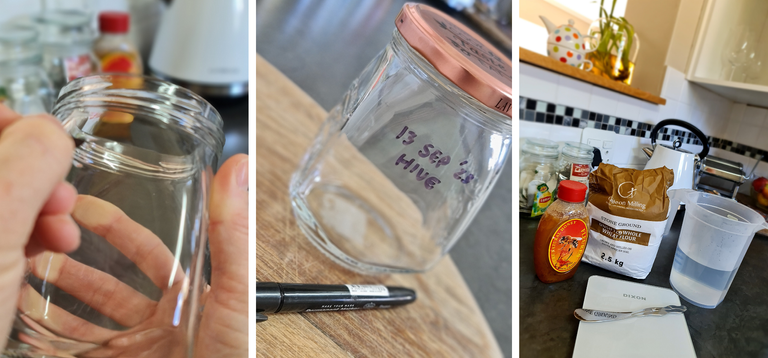
The Process
DAY 1.
The making of a sourdough starter is not rocket science, but I do feel that the perfecting of it... somewhat is a science! I am far from the stages of perfection, but I have managed to bake some seriously delicious breads for us so far and it has proven a wonderful form of therapy.
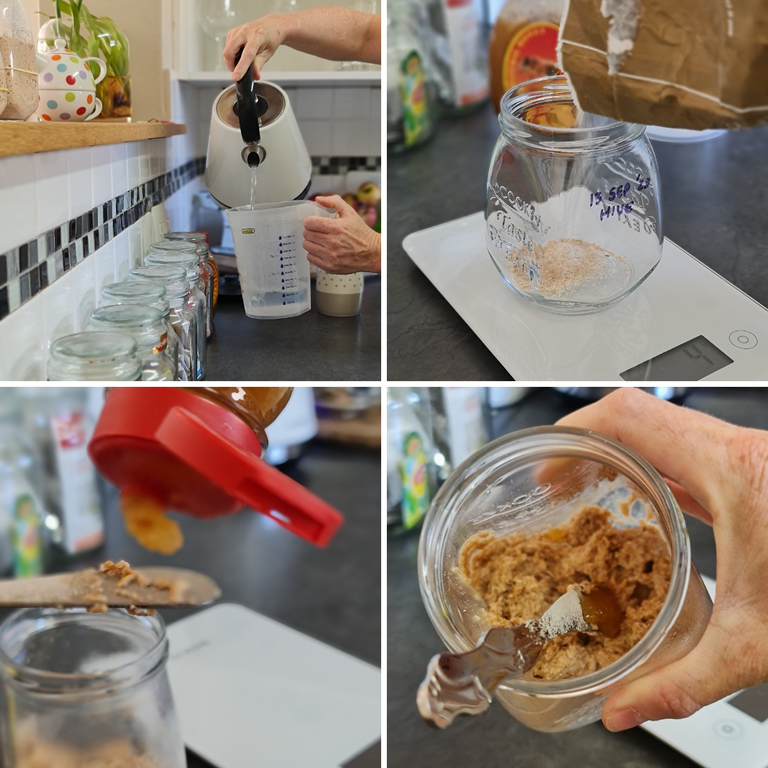
So, grab your scale, turn it on and place the empty, open glass jar on it. Then tare the scale (set it to zero). Add the 50g of flour into the jar, tare the scale again and then add the 50g of hot water. Lastly, add the 1/2 a teaspoon of honey. Give it all a really good mix, making sure there are no bits of dry flour left behind - although, I have noticed that the wholewheat flour is much quicker to absorb the fluids and doesn't create dry bubbles like other flours do.
Pop the lid on, but only loosely! Add the elastic band to the jar at the current starter height and leave it for 24 hours, on a counter at room temperature and NOT in any direct sunlight. - you will adjust the elastic band every time you feed it, so that you can begin to observe the growth height after each feed.
DAY 2.
After 24 hours, add another 50g flour, 50g VERY WARM water and another 1/2 teaspoon of honey. Give it a mix, pop the lid on, but not too tightly, adjust your elastic band to the top height of the starter and leave it for another 24 hours.
DAY 3.
Just give it mix, close it up and adjust the elastic band.
DAY 4 ONWARD.
I will be back with another post to guide you through the process from day four onward - but there is enough for you to do for now.
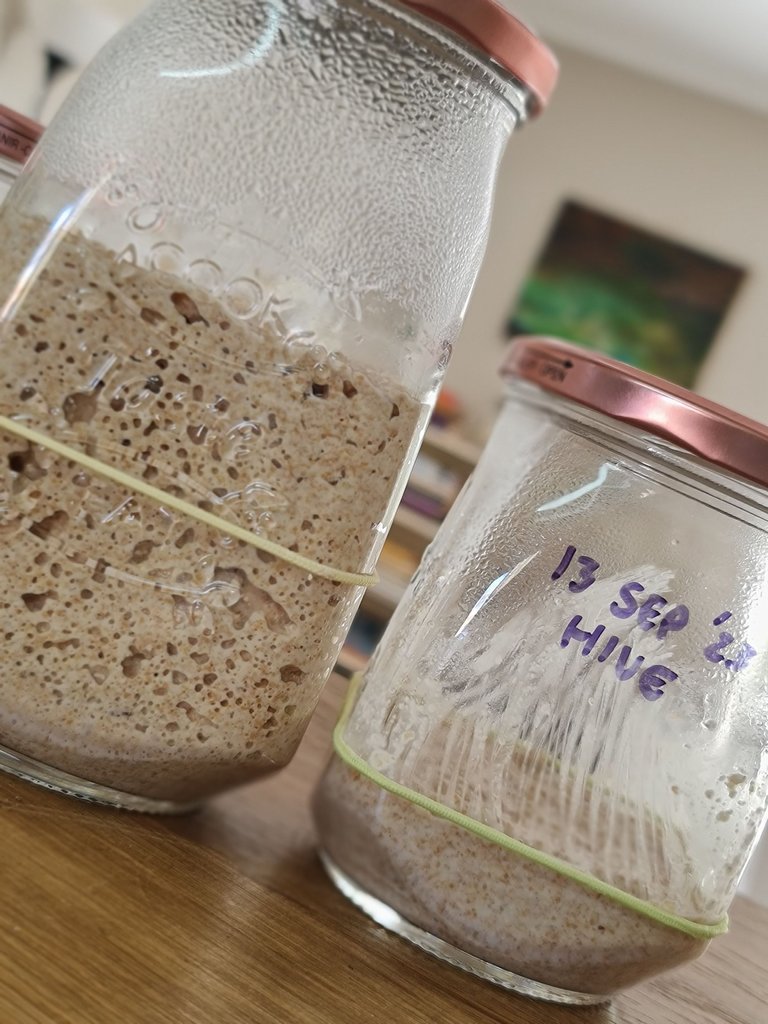
The Adventure Begins!
It is tradition to name a sourdough starter because when well looked after and used often for baking, they generally tend to stay with us for a very long time! In fact, according to Google... the oldest starter in the world is something like 4500 years old!
So, as I have begun this starter specifically to document here on Hive - I thought it would be fun for you guys and gals to put forward some name suggestions for our new baby in the comments below! 👇 If there is a positive response to this, perhaps we can do a poll for the final choice and add a reward of some kind to the the winning name... but let's see how it goes!
I will be back to continue the process from day 4 onward, but tomorrow is baking day, which means today is dough making day for me... so I am heading back off to the kitchen to carry on with that!
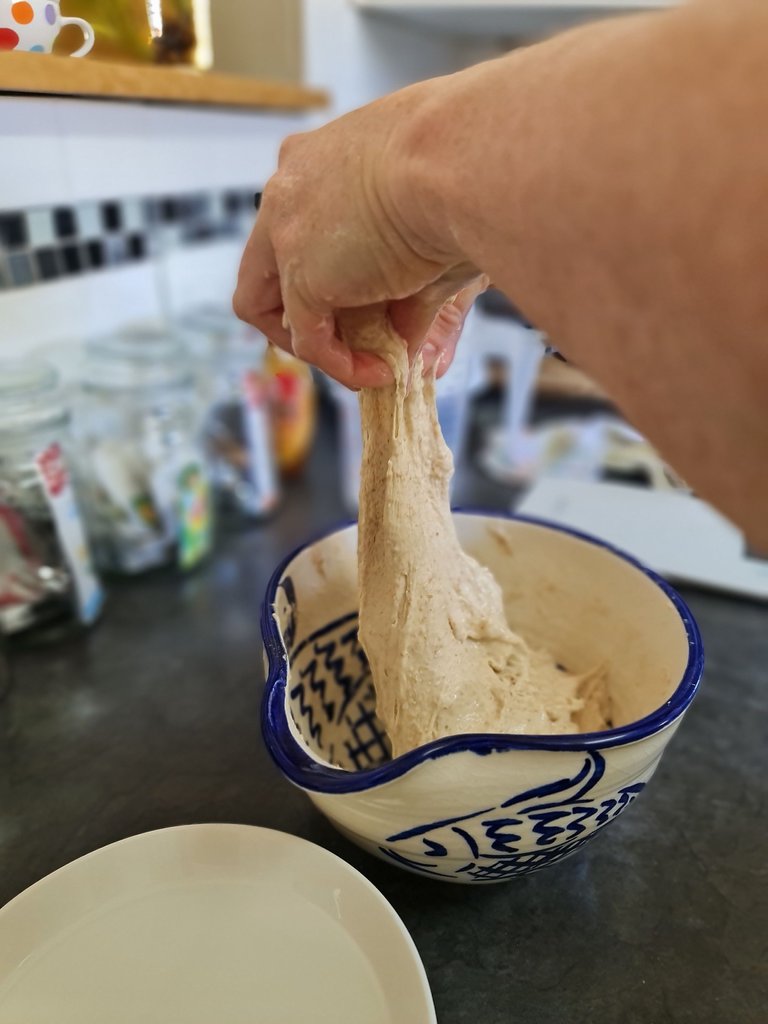
❤❤❤
Until next time...
Much Love from Country Bumpkinland, South Africa xxx
Jaynielea

ALL IMAGES ARE MY PROPERTY UNLESS OTHERWISE CREDITED
Typos make me human. I may or may not get around to correcting them.
Good bread is the most fundamentally satisfying of all foods; and good bread with fresh butter, the greatest of feasts.”
― James Beard
Jaynie, as usual, your cooking posts leave me drooling.
I love sour dough bread but have yet to get around to making it. I am thusly inspired.
As for naming the starter, how about ... DroolFuel? Not only is it unique, it rhymes (which makes it memorable). And, it's easy to storyfy: "So, there was this guy in Florida who, while reading my post about making sour dough bread, started drooling and, apparently, dripping on his keyboard. He died from electrocution which, if you think about it, is a terrible way to go. Anyway, I named the starter in his honor. It seemed like the least I could do."
Quill
Love you Quill, lol
Congratulations, your post has been added to Pinmapple! 🎉🥳🍍
Did you know you have your own profile map?
And every post has their own map too!
Want to have your post on the map too?
Apologies @pinmapple - I made use of the footer from my previous travel post and omitted to remove your location detail haha!